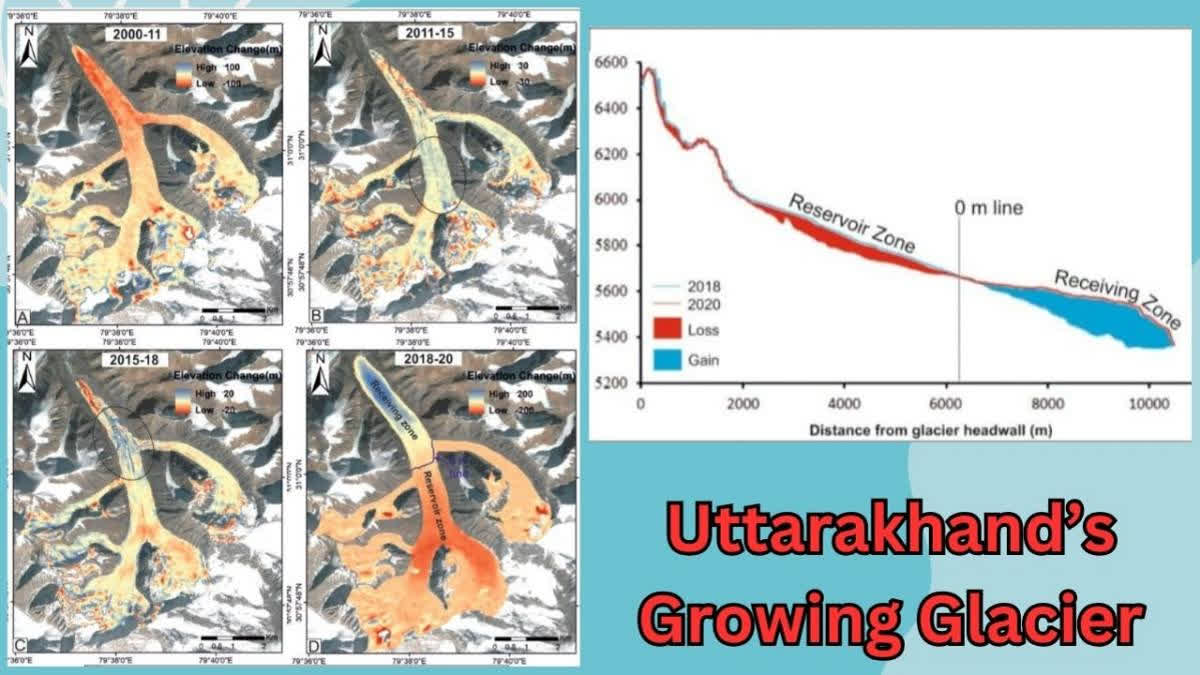Dehradun: Amid growing concerns over melting glaciers due to climate change, an unnamed glacier in the Dhauli Ganga basin of Uttarakhand has baffled scientists with its extraordinary growth. According to a study by the Wadia Insitute of Himalayan Geology, this glacier expanded by an astonishing 863 meters in just one month, a rare phenomenon that defies the prevailing trend of glacier retreat worldwide.
Located between the Randolph and Rekana glaciers in the remote Niti Valley, this glacier spans approximately 48 square kilometres. Its steady year-on-year growth has been observed through satellite data, offering new insights into surge-type glaciers while raising critical questions about the underlying hydrological and geological factors driving its expansion.
Location and Significance
The unnamed glacier in the Niti Valley of Uttakhand's Chamoli district lies at an altitude of 6,550 meters above sea level. Spanning an area of around 48 square kilometres, the glacier has been the subject of recent studies by scientists aiming to understand surge-type glaciers and their behaviours.
Image showing distance from the glacier headwall (Wadia Insitute of Himalayan Geology) Findings of the Study
A research paper titled 'Manifestation of a Glacier Surge in Central Himalaya Using Multi-Temporal Satellite Data' by Dr Manish Mehta, a glaciologist at the Wadia Institute, sheds light on the glacier's unusual behaviour. Dr Mehta highlighted that while glaciers globally are melting, this particular glacier has been increasing its area steadily over the years.
The rate of area expansion of the Unnamed glacier has been recorded as follows:
- 2001-02: 7.21 meters per year
- 2011-12: 15.59 meters per year
- 2013-14: 17.16 meters per year
- 2014-15: 15.08 meters per year
- 2015-16: 31.54 meters per year
- 2016-17: 23.31 meters per year
- 2017-18: 38.04 meters per year
- 2018-19: 55.94 meters per year
Between September 12, 2019, and October 14, 2019, the glacier saw an extraordinary surge of 863.49 meters in a single month.
Satellite image in blue circle showing location of unnamed glacier (Wadia Insitute of Himalayan Geology) Scientific Explanation
Dr Mehta explained, "Glaciers worldwide are melting, but some in the Himalayan region of Uttarakhand are showing peculiar behaviours. The unnamed glacier in the Dhauli Ganga basin is not advancing due to heavy snowfall but is experiencing an area surge due to other factors."
The change in the size of the glacier between 1993 and 2022 is shown in the picture (Wadia Insitute of Himalayan Geology) Key Factors Behind the Surge:
- Hydrological Pressure Melting:
"An increase in temperature causes the water in the glacier basin to seep to its base, creating pressure that pushes the glacier forward," said Dr Mehta.
2. Geological Conditions:
"The presence of liquids on the rocks beneath the glacier can also contribute to its forward movement," he added.
3. Thermal Contrast:
"Thermal Variations in the glacier basin might also be playing a role in this unusual expansion," Dr Mehta suggested.
Challenges in Studying the Glacier
Accessing the glacier has proven difficult due to its remote location and harsh terrain, Most observations have been made using satellite data. "A deep study is challenging because the area is inaccessible. All findings so far have relied on satellite-based analysis," said Dr Mehta.
Changes in the unnamed glacier during 2011, 2017 and 2020 (Wadia Insitute of Himalayan Geology) Broader Implications
The study of this glacier is crucial for understanding surge-type glaciers and predicting the potential risks they may pose. "This research not only enhances our knowledge of glacier behaviour but also helps us prepare for disasters that could arise from such phenomena," said Dr Mehta.
A Rare But Concerning Phenomenon
Despite the excitement over this rare occurrence, scientists urge caution. The glacier's unusual growth may indicate underlying hydrological or geological events that warrant further investigation. Dr Mehta concluded, "This phenomenon is not necessarily a sign of positive change. Understanding these glaciers is vital for mitigating risks and protecting the region's ecology."
Changes in the glacier from 2001 to 2022 (Wadia Insitute of Himalayan Geology) Read More
- Himalayas Need Urgent Attention: 65% Faster Loss Of Glacier Mass Leading To Irreversible Changes
- WATCH: Glacial Lakes in Uttarakhand Extremely Sensitive; Experts to Inspect Vasudhara Glacier of Chamoli
- Uttarakhand: Glacier Slides Down in Pithoragarh, Road to Indo- China Border Affected
- Climate Change Danger Looms Large as Avalanche Strikes Kedarnath Region
